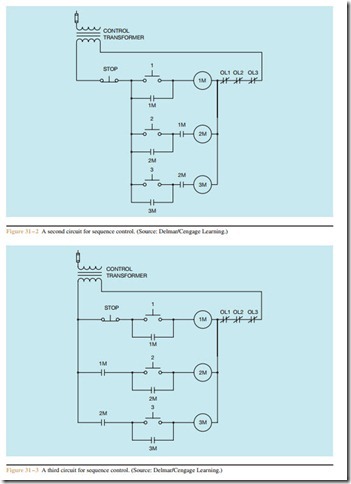Sequence Control Circuit #3
A third circuit that is almost identical to the previous circuit is shown in Figure 31 – 3. This circuit also employs the use of normally open auxiliary contacts to prevent motor #2 from starting before motor #1, and motor #3 cannot start before motor #2. These normally open auxiliary contacts that control the starting sequence are often called permissive contacts because they permit some action to take place. The main difference between the two circuits is that in the circuit shown in Figure 31 – 2, the stop push button interrupts the power to all the motor starters. The circuit in Figure 31 – 3 depends on the normally open auxiliary contacts reopening to stop motors #2 and #3.
Related posts:
PROGRAMMABLE-LOGIC AND APPLICATION-SPECIFIC INTEGRATED CIRCUITS (PLASIC):FIELD-PROGRAMMABLE-LOGIC DE...
Microphone Technology:Measurement Microphones
Troubleshooting and Repairing Computer Printers – Power supply service techniques
Electronics Explained - Learning about Electronics for Your Own Good
Developing a Wiring Digram (Circuit #2)
Interfacing and Processing:The Input
AC Servo Motors:Frequency Converter
Capacitor-Start Motor Connections
Digital Audio Fundamentals:Audio as Data
Electric Motor Manual – INSTALLATION METHODS - Portable instruments speed electrical troublesh...
MAINTENANCE OF MOTORS:INSULATION OF AC MOTORS
Lamps and Light Fittings:Tungsten Halogen Lamps
Fuel System part1
Troubleshooting control circuits:Basic control circuits
